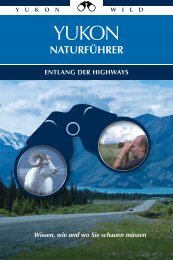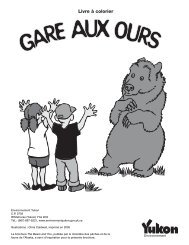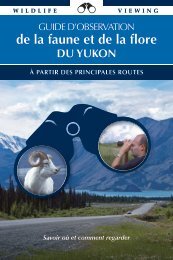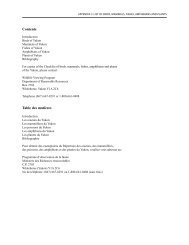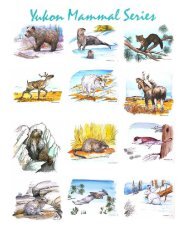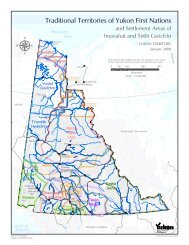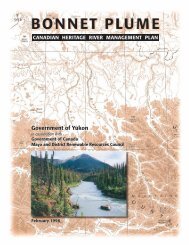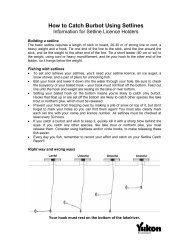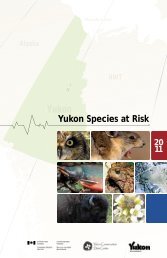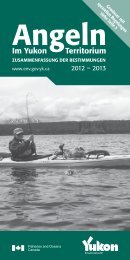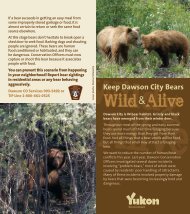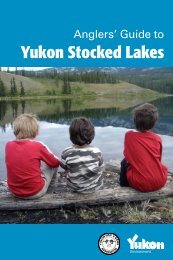Ch. 3 Land - Environment Yukon
Ch. 3 Land - Environment Yukon
Ch. 3 Land - Environment Yukon
Create successful ePaper yourself
Turn your PDF publications into a flip-book with our unique Google optimized e-Paper software.
An environmental review committee,<br />
with representation from First Nations<br />
and federal and territorial government<br />
agencies, then examines the information.<br />
Public meetings are often held in<br />
communities closest to the project. The<br />
mine will only proceed to the licensing<br />
stage after the environmental review<br />
committee has reviewed the baseline<br />
studies and mine plans, and the federal<br />
government is satisfied that environmental<br />
effects will be ameliorated. An<br />
important part of the environmental<br />
assessment is the abandonment and<br />
reclamation plan submitted by the mining<br />
company. This plan sets out how<br />
the land will be restored after the mine<br />
shuts down. It is this stage of mining<br />
that has caused the most concern in<br />
the <strong>Yukon</strong> in recent years.<br />
The <strong>Yukon</strong> Mining Industry<br />
Prospecting and exploring for hard rock<br />
or quartz minerals has had a long<br />
history in the <strong>Yukon</strong>. Each season, the<br />
territory is explored for a variety of<br />
minerals like gold, silver, copper,<br />
tungsten, nickel, coal, lead and zinc.<br />
The degree of activity depends on<br />
world market prices, demand for<br />
minerals and the investment climate.<br />
No. of Active Placer Mines<br />
250<br />
200<br />
150<br />
100<br />
50<br />
0<br />
1995 1996 1997 1998<br />
Figure 3.10 Active Placer Mines in<br />
the <strong>Yukon</strong>, 1995 to 1998<br />
Exploration activities are influenced by<br />
local discoveries or the availability of<br />
new geological maps. Figure 3.9 shows<br />
the fluctuations in mineral exploration<br />
spending over recent years. In 1998,<br />
low prices on the global market for<br />
gold and base metals are reflected by<br />
low exploration activity.<br />
<strong>Yukon</strong> placer gold deposits contribute<br />
up to five per cent of Canadian gold<br />
production. The number of active<br />
placer mines increased greatly in the<br />
late 1970s due to a sharp rise in the<br />
price of gold and has remained at<br />
about 200 since 1980 (Figure 3.10).<br />
The principal minerals produced in the<br />
<strong>Yukon</strong> are gold, lead, zinc and silver.<br />
The value of these four minerals from<br />
1985 to 1997 is shown on Figure 3.11.<br />
Mineral exploration and production<br />
have been the most significant nongovernment<br />
economic forces in the<br />
<strong>Yukon</strong> for more than 100 years. For a<br />
small economy, the <strong>Yukon</strong> has made a<br />
relatively significant contribution to<br />
global lead and zinc production. For<br />
example in 1996, production from<br />
<strong>Yukon</strong> mines accounted for 2.1 per<br />
cent of total world zinc production and<br />
3.2 per cent of total lead production.<br />
When fully operational, the lead-zinc<br />
mine at Faro had historically accounted<br />
$ millions<br />
350<br />
300<br />
250<br />
200<br />
150<br />
100<br />
50<br />
0<br />
for about 12 to 15 per cent of the<br />
<strong>Yukon</strong> Gross Domestic Product (GDP).<br />
Mineral Potential<br />
The complex geology of the <strong>Yukon</strong> can<br />
be roughly split into two rock groups:<br />
those north of the Tintina Trench and<br />
those south of it. This dividing line cuts<br />
northwest to southeast across the<br />
territory from Alaska to northern British<br />
Columbia, with each side characterized<br />
by different types of rocks containing<br />
different types of mineral deposits 1.<br />
The Tintina Trench is the huge valley<br />
formed by the erosion of the Tintina<br />
Fault Zone and is one of the territory’s<br />
most distinctive and significant physical<br />
features.<br />
Forces of erosion and deposition have<br />
concentrated secondary deposits of<br />
gold in river valleys. In most of the<br />
<strong>Yukon</strong> the glacial or ice-melt processes<br />
have dispersed the secondary gold<br />
deposits or covered them with thick<br />
layers of sediments. However, in the<br />
Klondike Plateau ecoregion there was<br />
little or no glaciation and the gold<br />
deposits are relatively undisturbed and<br />
easily accessible. Despite many years of<br />
exploration activity, the <strong>Yukon</strong> is still<br />
relatively poorly understood from a<br />
geological perspective. It is considered<br />
to have great mineral potential.<br />
1985 1986 1987 1988 1989 1990 1991 1992 1993 1994 1995 1996 1997 1998<br />
Figure 3.11 <strong>Yukon</strong> mineral production values<br />
C H A P T E R 3 L A N D ❧ 4 5<br />
Gold<br />
Silver<br />
Lead<br />
Zinc





